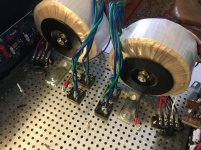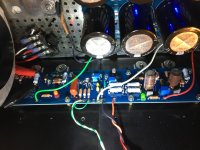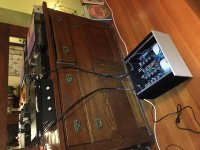If your PSU design accommodates individual TO-220 rectifiers with 3 legs, as for example the Universal Power Supply PCB in the diyAudio store does, then the Field Effect Rectifiers from ST Microelectronics are appealing. Their forward voltage drop is amazingly low, thus they dissipate far less power and require less heatsinking. Have a look at their Vfwd at 25 amperes. Amazing!
_
Which part is sufficient, without going to overboard for our uses here?
Field Effect Rectifier Diodes - STMicroelectronics | DigiKey
Thanks,
Russellc
Wow, FERD (not to be confused with FRED) diodes! Very cool.
I'm thinking The usual derating practice will work for these. Check out The Valve Wizard.
That suggests the 60V, 20A parts in the TO-220 package should be sufficient, but I would probably use the 100V parts for extra margin with some of my supplies.
I'm thinking The usual derating practice will work for these. Check out The Valve Wizard.
That suggests the 60V, 20A parts in the TO-220 package should be sufficient, but I would probably use the 100V parts for extra margin with some of my supplies.
Wow, FERD (not to be confused with FRED) diodes! Very cool.
I'm thinking The usual derating practice will work for these. Check out The Valve Wizard.
That suggests the 60V, 20A parts in the TO-220 package should be sufficient, but I would probably use the 100V parts for extra margin with some of my supplies.
Well I do like overkill, had sort of been looking at this one:
FERD30SM100ST STMicroelectronics | Discrete Semiconductor Products | DigiKey
Russellc
If your PSU design accommodates individual TO-220 rectifiers with 3 legs, as for example the Universal Power Supply PCB in the diyAudio store does, then the Field Effect Rectifiers from ST Microelectronics are appealing. Their forward voltage drop is amazingly low, thus they dissipate far less power and require less heatsinking. Have a look at their Vfwd at 25 amperes. Amazing!
_
Thanks Mark, much appreciated. I just ordered on Friday, a variety of TO-220 rectifiers based on your article from 2015 and RingNot thread, but most of those have a Vf of 1.4-2 volts, and will run much hotter than these FERDs. I'm in the layout process of the chassis and power supply right now. I won't be using circuit boards for the supplies, they will be on terminal strips of some sort, I may chassis mount the rectifiers or use individual heatsinks if I can.
I just made a few changes on my temporary mock up supply, and just wired freely in space on the workbench using only 2 ea per rail 27,000uF caps and dual bridges (KBPC3504) with R15 resistors in CRC fashion. With the inputs shorted, I get less than 1mV AC on the output, and 55mV ripple on the output supply cap. If I understand power supplies, that is pretty darn good for a 4A draw. So I am now wondering if I really need more capacitors than this? If I don't need 8 caps, I'd rather save them for another amp project. I will still go with the individual rectifiers for the finished amp, I'm just burning everything in now.
Thanks for the help.
Cheers
In my opinion, the Linear Audio article's key result is plainly stated in its first three lines:
Once you understand that, and internalize it, you can give yourself permission to choose low-Vfwd diodes if you like, secure in the knowledge that a 1R + 2C snubber will completely eliminate ringing. I will repeat that. Completely . Eliminate . Ringing .
That's why the "PSU for Chipamps" board that I sold in a Group Buy last December, uses Schottky diodes. They have low Vfwd so they run cool. You can see them running cool in a few thermal images I snapped; they're in the original thread:
PCB available: PSU for Chipamps , such as Super Gain Clone and Compact3886
ABSTRACT
Power transformer secondary ringing was measured with 48 different semiconductor diodes; ringing amplitude was 10-20X lower with the best diodes than with the worst. They all rang, including Schottkys and HEXFREDs. A 1R + 2C snubber directly across the secondary completely eliminated ringing in every case.
Power transformer secondary ringing was measured with 48 different semiconductor diodes; ringing amplitude was 10-20X lower with the best diodes than with the worst. They all rang, including Schottkys and HEXFREDs. A 1R + 2C snubber directly across the secondary completely eliminated ringing in every case.
That's why the "PSU for Chipamps" board that I sold in a Group Buy last December, uses Schottky diodes. They have low Vfwd so they run cool. You can see them running cool in a few thermal images I snapped; they're in the original thread:
PCB available: PSU for Chipamps , such as Super Gain Clone and Compact3886
I have started down the road to my build and I am in the parts acquisition stage. I have reached out to alweithttps://www.ebay.com/usr/alweit?_trksid=p2047675.l2559 on Ebay to try to obtain my IRFP240 matched quad sets. Are there any other reputable sources for matched IRFP24s since the store here is out of them? I understand I can purchase a sleeve from Mouser and test them myself to find matched quads but I would rather purchase mine in already matched sets. Any recommendations?
Aleph J performance:
I recently bought some KEF R500 tower speakers - with an 8-ohm impedance but a 3.2 ohm minimum - and the Aleph J runs them without any issue unless we're talking ear damaging sound levels.
Of course a smaller room and 88dB efficiency helps.
I recently bought some KEF R500 tower speakers - with an 8-ohm impedance but a 3.2 ohm minimum - and the Aleph J runs them without any issue unless we're talking ear damaging sound levels.
Of course a smaller room and 88dB efficiency helps.
Last edited:
Any harm in using 2 or 3 keratherm pads stacked for mosfets or rectifiers? Just asking in regards to an old post where an inadvertent hole was created causing short.
Thanks
Thanks
I have started down the road to my build and I am in the parts acquisition stage. I have reached out to alweithttps://www.ebay.com/usr/alweit?_trksid=p2047675.l2559 on Ebay to try to obtain my IRFP240 matched quad sets. Are there any other reputable sources for matched IRFP24s since the store here is out of them? I understand I can purchase a sleeve from Mouser and test them myself to find matched quads but I would rather purchase mine in already matched sets. Any recommendations?
I bought a tube (25 devices) from Digikey; I specifically noted in that order that I want the MOSFETS from the same tube.
When I was matching them, the first 10 I tried were all perfectly matched...
Later on, in Aleph J, I measured the voltage drops accros 0.47 ohm resistors - the readings were the same... within 1000ths of a volt +/- (0.451, 0.452, 0.450V, 0.451...)
Another Aleph J lives! Enormous thanks to all the help from members on this forum, 6L6 for the build guide, and of course to Mr. Pass. Special thanks to Dennis Hui for walking me through the process of matching the MOSFETS, which, after I figured out how to wire everything up, was super easy.
I'm pretty pleased with the layout I came up with. I took ZM's suggestion to run the mains underneath the riser, and, since I went dual mono, decided to put the fuse holders underneath as well.
I'm getting a little bit of high frequency hiss from the speakers, but nothing I can't live without. I'll probably give Extreme_Boky's hum elimination technique a try at some point. Otherwise, at first listen, it sounds absolutely fantastic. Elegant was the word that came to mind.
Signal chain: Pro-Ject turntable > Lounge Audio Phono Pre > BA3 FE Preamp > Aleph J > Back loaded horn enclosures with Fostex full range drivers.
I'm pretty pleased with the layout I came up with. I took ZM's suggestion to run the mains underneath the riser, and, since I went dual mono, decided to put the fuse holders underneath as well.
I'm getting a little bit of high frequency hiss from the speakers, but nothing I can't live without. I'll probably give Extreme_Boky's hum elimination technique a try at some point. Otherwise, at first listen, it sounds absolutely fantastic. Elegant was the word that came to mind.
Signal chain: Pro-Ject turntable > Lounge Audio Phono Pre > BA3 FE Preamp > Aleph J > Back loaded horn enclosures with Fostex full range drivers.
Attachments
Another Aleph J lives! Enormous thanks to all the help from members on this forum, 6L6 for the build guide, and of course to Mr. Pass. Special thanks to Dennis Hui for walking me through the process of matching the MOSFETS, which, after I figured out how to wire everything up, was super easy.
I'm pretty pleased with the layout I came up with. I took ZM's suggestion to run the mains underneath the riser, and, since I went dual mono, decided to put the fuse holders underneath as well.
I'm getting a little bit of high frequency hiss from the speakers, but nothing I can't live without. I'll probably give Extreme_Boky's hum elimination technique a try at some point. Otherwise, at first listen, it sounds absolutely fantastic. Elegant was the word that came to mind.
Signal chain: Pro-Ject turntable > Lounge Audio Phono Pre > BA3 FE Preamp > Aleph J > Back loaded horn enclosures with Fostex full range drivers.
Excellent job. Can you take a recording with your phone of the noise and post it?
Excellent job. Can you take a recording with your phone of the noise and post it?
Thanks! I don't see a way to post a recording, but hopefully this link will work: Nueva grabación 6.m4a - Google Drive
Note: I cranked the volume way up to accentuate the hum for the recording. At normal listening levels it isn't nearly this noticeable.
It's a combination of 100Hz buzz and broadspectrum noise...
To fix the mains frequency buzz, do as you mentioned already: "I'll probably give Extreme_Boky's hum elimination technique a try at some point."
For the white broadspectrum noise, it should disappear if you short the RCA hot pin to ground. If this is indeed the case, your source has a highish output impedance; try using a volume pot between BA3 FE Preamp output, and Aleph J input.
To fix the mains frequency buzz, do as you mentioned already: "I'll probably give Extreme_Boky's hum elimination technique a try at some point."
For the white broadspectrum noise, it should disappear if you short the RCA hot pin to ground. If this is indeed the case, your source has a highish output impedance; try using a volume pot between BA3 FE Preamp output, and Aleph J input.
It's a combination of 100Hz buzz and broadspectrum noise...
To fix the mains frequency buzz, do as you mentioned already: "I'll probably give Extreme_Boky's hum elimination technique a try at some point."
For the white broadspectrum noise, it should disappear if you short the RCA hot pin to ground. If this is indeed the case, your source has a highish output impedance; try using a volume pot between BA3 FE Preamp output, and Aleph J input.
Thanks for this diagnosis, Extreme_Boky. I haven't had a chance to try shorting the RCA hot pin yet but will give that a go soon. If that's the issue are you suggesting I should re-wire the BA3 FE so the volume pot comes after the BA3FE board (I currently have it wired according to 6L6's build guide - before the PCB), or that I should add an additional volume pot to the chain?
spryror,
Neat build you got there - enjoy!
Thanks! I'm enjoying it very much so far. 😀
- Home
- Amplifiers
- Pass Labs
- Aleph J illustrated build guide





